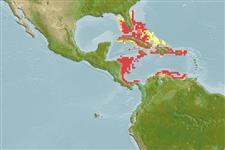Issue
The species in the genera Spratelloides Bleeker, 1851 and Jenkinsia Jordan & Evermann, 1896 should most probably be assigned to a separated family from Clupeidae and Dussumieriidae (Lavoué, pers. comm., July 2013). See a preliminary analysis in Lavoué et al. (2013: Ref. 93878).
Environment: milieu / climate zone / depth range / distribution range
Ökologie
seewasser riff-verbunden; tiefenbereich 0 - 50 m (Ref. 188). Tropical; 31°N - 8°N, 85°W - 64°W (Ref. 188)
Western Central Atlantic: Florida, Belize, Venezuela.
Size / Gewicht / Alter
Maturity: Lm ? range ? - ? cm
Max length : 4.0 cm SL Männchen/unbestimmt; (Ref. 188)
Rückenflossenstacheln (insgesamt) : 0; Afterflossenstacheln: 0; Wirbelzahl: 38 - 39. Pre-maxillae toothed, triangular; 1 supra-maxilla; isthmus broadly triangular, pointed anteriorly; W-shaped pelvic scute; vertebrae 38 to 39 (usually 39 - Venezuela). Silver lateral band not becoming narrower or fading anteriorly.
Usually occurring inshore. Forms schools. Feeds on plankton. Probably grows to 5 or 6 cm SL.
Life cycle and mating behavior
Maturities | Fortpflanzung | Spawnings | Egg(s) | Fecundities | Larven
Whitehead, P.J.P., 1985. FAO Species Catalogue. Vol. 7. Clupeoid fishes of the world (suborder Clupeoidei). An annotated and illustrated catalogue of the herrings, sardines, pilchards, sprats, shads, anchovies and wolf-herrings. FAO Fish. Synop. 125(7/1):1-303. Rome: FAO. (Ref. 188)
IUCN Rote Liste Status (Ref. 130435)
Bedrohung für Menschen
Harmless
Nutzung durch Menschen
Fischereien: kleinfischerei
Tools
Zusatzinformationen
Download XML
Internet Quellen
Estimates based on models
Preferred temperature (Ref.
123201): 24.9 - 28.1, mean 27.2 °C (based on 108 cells).
Phylogenetic diversity index (Ref.
82804): PD
50 = 0.5625 [Uniqueness, from 0.5 = low to 2.0 = high].
Bayesian length-weight: a=0.00389 (0.00180 - 0.00842), b=3.12 (2.94 - 3.30), in cm total length, based on all LWR estimates for this body shape (Ref.
93245).
Trophic level (Ref.
69278): 3.4 ±0.45 se; based on food items.
Widerstandsfähigkeit (Ref.
120179): hoch, Verdopplung der Population dauert weniger als 15 Monate. (Preliminary K or Fecundity.).
Fishing Vulnerability (Ref.
59153): Low vulnerability (10 of 100).
